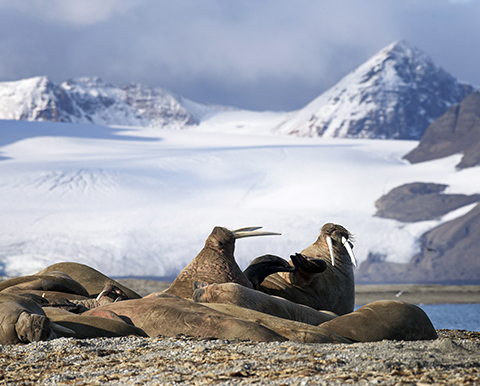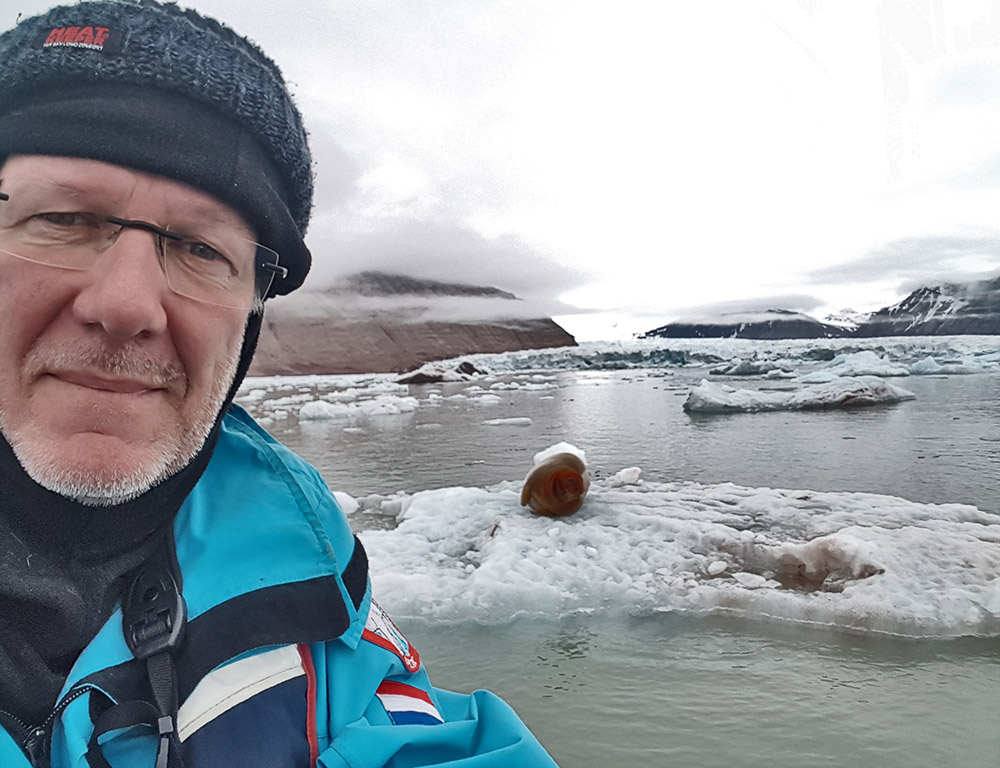
Maarten Loonen puts on a brave face
Watching the world melt
Maarten Loonen is panicking.
He doesn’t want to show it; he can’t – it’s his job to put on a brave face. He’s learned that people can only hear so many warnings of impending doom before they stop listening altogether. And he can’t let that happen.
So the polar researcher tries to stay upbeat. Students skipping school to protest climate change give him hope. He loves the fact that there’s an increasing number of vegetarians and that he sees ever more solar panels on roofs. He’s happy about the Paris Climate Accords and the verdict in the Urgenda case, where the courts told the Dutch state to decrease greenhouse gases by 25 percent in 2020. Change is happening, he says.
Identity
And there’s more good news: five years after largest Dutch polar expedition ever – the Scientific Expedition Edgeøa Svalbard (SEES) – he and his colleagues, Frits Steenhuisen and Annette Scheepstra from the RUG Arctic Centre, get to go again. On the second expedition, a ship full of scientists, journalists, and tourists will travel to Svalbard to do research, exchange ideas, and, most importantly, tell the world about what’s happening. ‘We might start organising an expedition every five years’, says Loonen.
The land, the stories; they’re all part of me
He wants to stay positive, but it’s not easy when he has good reasons to panic.
He becomes visibly emotional when he speaks about Svalbard, the archipelago that’s been his home five months out of every year since 1990. ‘Svalbard is so ingrained in my identity’, he says. ‘The land, the stories; they’re all part of me.’ He’s forced to watch the destruction of this beautiful landscape –magnificent still, in spite of everything – as global warming wreaks slow havoc on it. People should know about this, he says. We have to make them understand. We have to do something. ‘It’s not too late. The good news is that we can still stop it, if we hurry.’
Deadly methane
So how long do we have? When do we reach the point of no return, when the glaciers melt and the sea levels rise so high that Bangladesh floods, all the way on the other side of the globe? When do we reach the point when the permafrost thaws and thousands of cubic metres of deadly methane gas are released? When do reach the point when the amount of fresh water and CO2 in the Gulf Stream changes it so much that it either stops moving or shifts to a different location?
We can no longer deny that something terrible is happening.
Climate change was already noticeable on Svalbard five years ago, when summer lasted twelve weeks instead of six. The scientists were being stung by mosquitoes – which had never happened before. The glaciers had shrunk, and the polar bears had abandoned their sea-ice habitats to search for food on land.
Sleet
What’s the situation on Svalbard like today?
‘The average temperature has gone up by another 1.5 degree Celsius in the last five years’, says Loonen. ‘The amount of sea ice has decreased from 6.3 to 4.6 million square kilometre over the past summer.’
He remembers 1994, when there was sleet – a disastrous event on Svalbard, where the air is typically cold and dry. Sleet makes it impossible for starving reindeer to find food; dead reindeer lead to a surge in the fox population; the foxes, in turn, attack young geese en masse. ‘It’s a cascade.’
There’s one record after another: every year it gets a little warmer.
Maar tegenwoordig, zegt Loonen, ijzelt het ieder jaar. ‘De fjord, waarover al sinds mensenheugenis een ijsweg loopt in de winter, vriest niet meer dicht. Lawines zijn overal. De gletsjers trokken zich al 2,5 kilometer terug.’ De temperatuur? Het is één lange reeks van ‘records’ – elk jaar een beetje warmer. En wat mensen niet beseffen is hoe die hogere temperaturen dus jaar na jaar verwerkt worden in de klimaatgemiddelden. Shifting baselines, noemen wetenschappers dat.
Ice age
Whenever someone says that it’s one degree warmer than average, that average is much higher than it was, say, fifteen years ago. Loonen says the climate was basically stable for ten thousand years, from the last ice age, when people started to settle along the coasts and practicing agriculture, to now. But that’s changing.
The worst part is that climate change is extremely complicated. We are rapidly gaining knowledge on how the system of climate works, but it’s turned out to be much more complex than we previously thought.
He remembers when marine biologists said that Svalbard would hardly be impacted by global warming because the surrounding ocean would serve as a buffer. This unfortunately turned out to be false. The cold cover of ice on the water is disappearing and the warmer water evaporates, turning into water vapour, which is a greenhouse gas because clouds store that heat.
Tripled
He remembers when glaciologists believed that glaciers were growing because of precipitation in the hinterlands. The weight of the ice was pushing them towards the sea where the glaciers would melt. But now we know that the precipitation in the hinterlands, rain in particular, is actually being absorbed by the ice; the water lifts the glaciers, moving them towards the sea. The more it rains, the faster the glaciers move.
The cycle can’t shift north because there is no north to shift to.
The precipitation in the hinterlands of Svalbard has tripled over the past few years, and there’s no going back.
He remembers when marine biologists thought the CO2 in the seawater would be buffered, maintaining the water’s pH levels. But now they know this isn’t true. Seawater is becoming more acidic, which means that animals that produce calcium will die off. This will start on the poles. ‘And let’s not forget that all calcium deposition is done by marine animals’, says Loonen.
Demagoguery
This doesn’t mean that all these scientists were wrong and that global warming may not be that big of a deal after all. What it does mean is that when one thing shifts, everything else shifts, too. It also means that it would be foolish to think we could just stop that from happening.
Loonen’s voice is full of emotion. ‘The cycle of ice that we used to have is just disappeared. It can’t shift north, because there is no north for it to shift to. The geese I study on Svalbard have been trying to adapt, but it’s all just happening too quickly.’
But he has to stay positive. There is still time to make a difference, but we have to act now.
He lashes out at politicians. At Henk Kamp with the VVD, who says it’s fine to cut down trees: ‘Because we’re planting new trees, he says. As though a tiny sapling can absorb as much CO2 as a full-grown tree! What on earth is he trying to pull? It’s plain demagoguery.’
Best behaviour
He lashes out at FvD’s Thierry Baudet, who claims that climate action is useless and too expensive. ‘But he won’t have to explain himself when the future changes and we have to pay for it in twenty years.’
He lashes out at Prime Minister Mark Rutte and his efforts to slow down climate action, saying we’re in no rush because we have until 2030 to fix it. ‘No rush? How dare he! He’s straight up lying. Waiting until 2030 to take action will cost us six times as much.’
No rush? How dare he! He’s straight up lying!
And why shouldn’t we try to be on our best behaviour? What’s wrong with being a leader when it comes to climate action? It could give the Netherlands an innovative advantage. We might even make money off it.
But more importantly: ‘Surely we want to be on the right side of history? If it does all go wrong, if Bangladesh is forced to escape the floods, I don’t want to have to say that I knew about this but didn’t do anything.’
Comparing things to the Second World War is a slippery slope, he knows that. And yet. ‘One day we’ll consider this just as tragic as the Second World War. People will have been either “good” or “bad”.
Back then you also had the collaborators, the resistance fighters, and a frighteningly large group of indifferent people.’ He shakes his head. ‘Why shouldn’t we try to be good? This affects everyone.’ He’s silent for a moment. ‘This affects me.’
Five years ago, Maarten Loonen realised his dream; he started the Scientific Expedition Edgeøa Spitsbergen (SEES), the largest Dutch polar expedition ever. Scientists from various fields joined journalists, artists, and opinion-makers on a journey to Edgeøa on Svalbard to catalogue the consequences of global warming.
Edgeøa is a good location for this because a Dutch research station made its home there during the sixties and seventies, collecting copious amounts of data on temperature, flora, and fauna.
Last week, it was announced that SEES will be organised again. During this second addition, the focus will be on projects from young researchers. Biologists, archaeologists, geologist, glaciologists, and climate scientists from the RUG, Wageningen University & Research, University of Utrecht, VU Amsterdam, and the NIOZ will all be coming on the expedition.


